
Health 'Insurance' at Sea: 1 2 3 4 5 6 7 8 9 10 11 12 13 Next>>
Health 'Insurance' at Sea During the Golden Age of Piracy, Page 7
Intermediate Health Care - Navy: Hospitals Ships
"[Hospital Ships] may have been required as much for the maintenance of morale as for any service they might in fact render. The importance attached by seamen to medical treatment is indicated by the assurance, made in March, 1693, to seamen of the Scots navy, that they would be cared for in English hospitals should they be wounded while serving in one of the king's ships.” (John Keevil, Medicine and the Navy 1200-1900: Volume II – 1640-1714, p. 178)
The first English Navy hospital ship of which we know was used in 1620 in the Algiers Expedition, "in the fleete of
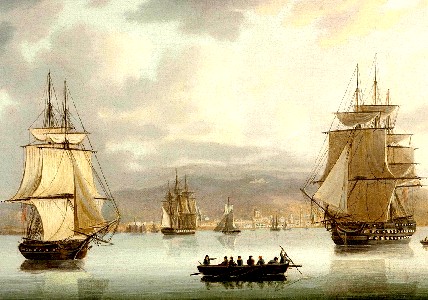
Artist: Thomas Butterworth (19th c.)
ships sente out by the King his most excellent Majestie as well against the pirates of Algiers, as others, the whole bodie of the Fleete consisting of 18. sayle."1 The Goodwill was used both as a hospital and store ship, "but it was a most inadequate venture and most of the sick were treated on shore."2
Whether the Goodwill was effective or not, hospital ships were still considered an important part of a naval fleet. Writing about 10-20 years later, Nathaniel Boteler explained this in his Dialogues.
…Captain, have you not in all great fleets, certain ships appointed for the receipt of your sick people, which you call hospital ships?
Captain. Yes. And there is nothing more necessary than that every squadron of such fleets should be very sufficiently furnished with them; and that these ships be appointed and known before the fleet puts out to sea, and that they be fitted with convenient cabins, for the receipt of the sick people, and very ship provided with an able Chirurgeon with his Mate, to be continually resident aboard, who is to have his chest every way well furnished; that so as any person, either common man or common officer shall happen to fall sick, and especially of a sickness known or suspected to be infectious and contagious in any ship of the squadron, he may be speedily and with the first opportunity removed and received into that hospital ship which is appointed for it; the sound, but likewise be the better lodged and looked unto by the Chirurgeon.3
Hospital ships began to appear in earnest in the English Navy during the Second Dutch War. Surgeon General to the
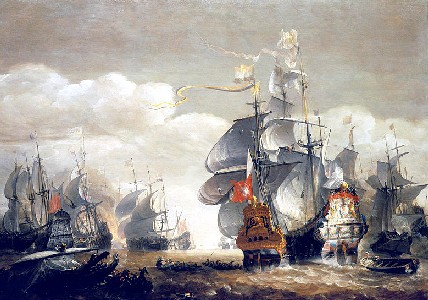
Artist: Hendrik Van Minderhout - Battle of Lowestoft (c. 1665)
Fleet James Pearse wrote to Samuel Pepys in 1665 requesting "that a hospital ship be sent speedily to the fleet with all necessary provisions"4. Three days later the Duke of York's secretary Sir William Coventry wrote to ask Pepys for two hospital ships "well fitted with cradles [frames to protect amputated limbs from the bed clothes5] and surgeons, to attend the fleet."6 Although the need for these ships was highlighted by a second letter written by Coventry, only one hospital ship - the Loyal Katherine - was able to join the Duke of York's fleet in time for the Battle of Lowestoft.
The hospital ships were useful. Sea surgeon Hugh Ryder, working on the Loyal Katherine talks about being "in the Hospital Ship in the year [16]65, after that great Engagement with the Dutch on the third of June... [where] from each Man of War were put aboard us their wounded Men"7. Ryder notes that at one point there were "above five hundred wounded Men aboard, near two hundred of them with amputations, the rest with Compound Fractures, and other Wounds by Gun-shot"8.
The second hospital ship the was originally requested - the Joseph - was hired for use on June 9th. Due to a shortage in manpower for this ship, it saw little use. Men were often diverted from hospital ships to warships during this war because the fighting ships could also be used to transport the wounded. In fact, two fireships used for this purpose in November of 1665. Nevertheless, when the contract was running out for the Joseph in December, Pearse wrote to Pepys to emphasize "the absolute necessity for another hospital ship."9 As a result, the Maryland Merchant was hired in 1666 as a replacement.
For the Third Dutch War, the Privy Council in 1672 ordered fifty warships and two hospital ships. These two
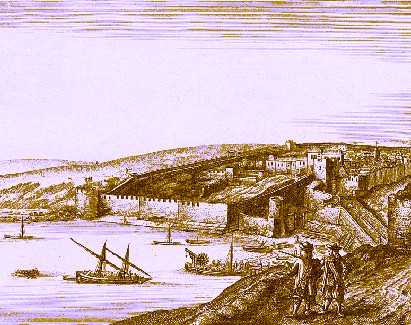
Artist: Wenceslas Hollar - Port of Tangier (mid-late 17th c.)
ships were merchant ships modified to serve as hospital ships for intermediate health care and transport of wounded and ill men back to shore.10 Two hospital ships proved to be inadequate for the war; John Knight, superintendant of the hospitals found that the hospital ships which were supposed to return healed men to their ships "were liable to be called away just when he wanted them"11. A hospital ship with orders to call on him to return healed men to the ships instead wound up convoying 30 ships hauling coal, leaving his men without transport.
Hospital ships even found use outside of wartimes. When the forces stationed in Tangiers were withdrawn in 1683, "the arrangements for evacuation included the requisitioning of two small merchantmen [for use] as hospital ships, the Unity and the Welcome. ...Pearse had the satisfaction of seeing his views on hospital ships thus accepted, even in peace-time."12
For William's War, the Sick and Hurt Commission decided to increase the number of hospital ships in use. Their logic was bolstered by several factors. These included the difficulty in convincing lodging-house keepers to quarter men (due to non-payment in the past, as explained previously), the loss of the use of the Savoy and Ely House hospitals and challenges created by wounded and healing men deserting when they were on land.13 Such reasons were clearly embraced judging by the number of hospital ships that were active from that period forward, as seen in the chart below left. A large number of hospital ships were also used in Anne's War as the chart shows, suggesting that the increase in hospital ships for William's War was a success.
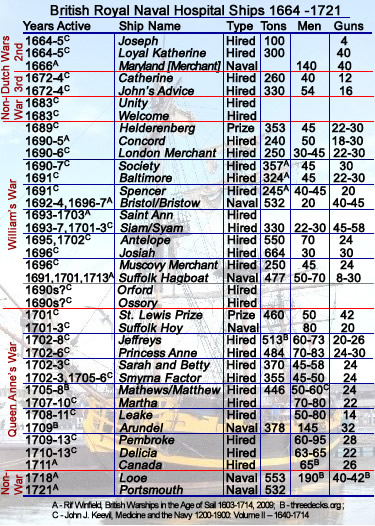
Background Photo: Nelson Light - Grand Turk, 6th Rate Replica Ship
Several notes on the hospital ship chart are pertinent to understanding this data.
There are 37 different ships on the list. The ships come from three different sources: A: Rif Winfield's British Warships in the Age of Sail, 2009; B: The Threedecks.org website and C: John Keevil's Medicine and the Navy 1200-1900, Vol. 2.
The superscripted letter by the year indicates the source of information for the entire row of information in most cases. The exception to this is when there is a superscripted letter on a piece of data other than the year, indicating that that particular data comes from the source noted. Keevil's information is preferred over other sources because his focus is on medicine and his research is tailored to that.
Due to normal spelling and reference variances in period documents, a few ships have multiple names.
The ship tonnage is represented in builder's old measurement (bm), which estimated the tonnage of a ship based on length and maximum beam or width of the ship at its widest point at the waterline. All tonnage numbers have been rounded to the nearest whole number.
The red horizontal lines represent the division between different wars and periods of peace. The corresponding wars are listed on the left side of the chart in red. The blue horizontal lines are only included for readability and have no other meaning.
It is possible that this list is incomplete because the British Navy's records of hired ships itself does not appear to be complete. For example, two of the ships on the list – the Orford and Ossary – are mentioned only by Keevil; he was unable to find any information about them other than their names and status. Keevil notes that they are only known because they were discussed by naval surgeon Patrick Campbell who had served on them.14 When Campbell wrote about his experiences on the Ossary, he said it was stationed in Altea Bay, Spain in 169515. Further information about the dates that the Ossary and Orford were used by the Navy are not found in any of the three sources used, so their dates on the chart are shown as '1690s?'.
Many of hospital ships shown as Naval ships were old 5th or 6th rates which were converted into hospital ships. For example, the Looe was built for the navy as a 5th rate frigate by the Blackwall yard and launched in 1707. It was converted 
Artist: William Hogarth - Woodes Rogers (1729)
into a hospital ship and recommissioned in March of 1718 for the Baltic. However, in 1719 it took a Spanish privateer, suggesting its role may have once again been changed back to a warship.16 When such information can be pinpointed, the dates shown in the chart are only for the period during which the ship served as a hospital ship.
The navy weren't the only sailors to designate ships to be used as hospital ships. During his crown-sanctioned privateering voyage, Woodes Rogers took a prize ship in late March of 1709 which was named the Increase. They cleaned the vessel (to allow it to travel faster) then launched their "new Boat to tow at our stern"17. Captain Edward Cooke explains, "We put our sick Men Aboard [the Increase], took several Planks and Boards out of her, for the Use of our Ships [the Duke and Dutchess], and out of both [of the other] Ships put 20 Men Aboard "18. A doctor from both the Duke and Dutchess were also put aboard, with William Stratton being made captain and Alexander Selkirk the Master of the ship.19
1 John Button, Algiers voyage in a iournall or briefe reportary, 1621, not paginated; 2 Sir Cecil Wakely, Surgeons and the Navy, transcript of Thomas Vicary Lecture delivered at the Royal College of Surgeons in England, 11/14/1957, p. 277; 3 Nathaniel Boteler [Butler], Boteler's Dialogues, 1929, p. 64; 4 John J. Keevil, Medicine and the Navy 1200-1900: Volume II – 1640-1714, p. 84; 5 Thanks to John Hinman for helping me to determine this; 6 Keevil, p. 84;7 Hugh Ryder, New Practical Observations in Surgery Containing Divers Remarkable Cases and Cures, p. 88; 8 Ryder, p. 89-90; 9 Keevil, p. 86; 10 Keevil, p. 116; 11 Keevil, p. 120; 12 Keevil, p. 142; 13 Keevil, p. 174; 14 Keevil, p. 247; 15 Keevil, p. 298; 16 "British Fifth Rate frigate 'Looe' (1707)", threedecks.org, gathered 2/21/16; 17 Woodes Rogers, A Cruising Voyage Round the World, p. 82; 18 Edward Cooke, A Voyage to the South Sea and Round the World in the Years 1708 to 1711, p. 123; 19 Rogers, p. 83
Intermediate Health Care - Navy: Hospitals Ship Purpose
The Navy and the Sick and Hurt Commissioners each had different ideas about the purpose of a hospital ship. The Navy tended to view hospital ships as a way to convey sick and wounded men back to shore where they could be treated. The Sick and Hurt Commissioners felt that the ship itself could serve as a place for sick and wounded treatment, operations and dressing. Based on their experience using hospital ships during the second Dutch war, the Navy decided "that much equipment was needed for a hospital ship, that treatment in one was difficult, and that transports would better serve naval requirements in coastal battles, at least from the administrative if not the medical standpoint."1
_Wenceslas_Hollar_17th_c.jpg)
Artist: Wenceslas Hollar - Small Merchant Ships 17th c.)
The problem with effective treatment on a hospital ship was exacerbated by the Navy's unwillingness (or perhaps just inconsideration of the need) to reveal the equipment requirements for different ships to the Barber-Surgeons Company, who supplied the ships. This created problems when two hospital ships of different sizes, such as the Loyal Katherine of 300 tons and the Joseph of only a hundred, were provided with the same supplies. In addition, the Company did not know how actively each hospital ship was used, which resulted in 'recurrent shortages' on one ship while the other was hardly used at all.2
Because the navy had such little regard for treatment of men at sea on hospital ships during the second Dutch War, the vessels were not modified to facilitate treatment of the sick and wounded. They were left heavily armed; the Loyal Katherine and the Maryland Merchant each had 40 guns. As a result, "these ships were liable to be diverted to the protection of east-coast collier [coal ship] fleets in need of an escort" rather than be used for their intended purpose.3
This in turn led to the hospital ships not being available to transport wounded men. Because of this, the sick and wounded had to remain aboard warships until they could be make their way back to port and safely land the men requiring treatment. While in Barcelona, Sir John Leake "pointed out that several of the third rates already had a hundred and some a hundred and fifty sick on board, and that further crowding with invalids might render them useless 'if there should be occasion for action'."4 (Third rate ships at this time normally had between 360 and 600 men on board.)
During Anne's War, responsibility for equipping the hospital ships was taken away from the Barber-Surgeons and given to the fifth Sick and Hurt Commission. In early 1703, the Commission was asked to suggest ways to better provision hospital ships.
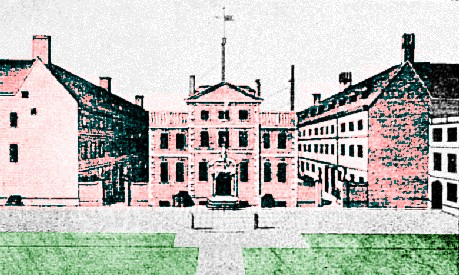
Navy Office Headquarters From 1656-1788 (1750)
Their response upset the Navy Office, highlighting the differences in views on the purpose of these ships. "[T]he Commission for Sick and Wounded, composed as it was in part of medical men, regarded the hospital ship as required for a single purpose, while Navy Office looked on it as little more than a temporary means of transporting patients and available at other times as a store-ship or for escort duties."5 Because of the protracted discussions between the Commission and Navy Office over the purpose of hospital ships, the fleet sailed in the summer of 1703 without any hospital ships.
The Navy eventually sought opinions from the master shipwright of the yard about the hospital ships. This resulted in the Navy Office deciding "that more room for patients on the gun-deck should be provided by limiting the space given to store-rooms, cabins and to the ship's company, and by transferring these to the hold."6
1 John J. Keevil, Medicine and the Navy 1200-1900: Volume II – 1640-1714, p. 95; 2,3 Keevil, p. 103; 4 Keevil, p. 220; 5,6 Keevil, p. 240

